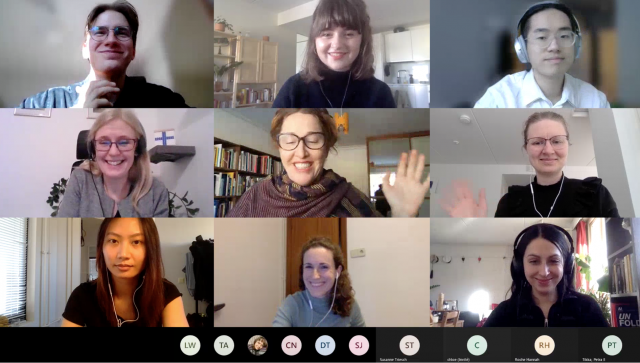Backstage of online work
This blog post reports on work-in-progress within the DfG course! The post is written by the group dealing with the Ministry of Interior’s brief on ‘Strategy for expatriate Finns’.
Group 3A: Rūta Šerpytytė and Liisi Wartiainen from Collaborative and Industrial Design program, Chloe Pillon from Creative Sustainability program, and Kaisa-Maria Suomalainen from Future Studiesprogram (University of Turku).
The spring of 2021 started together with the Design for Government course. Together with our diverse, multicultural team of four, we began tackling the brief provided by the Ministry of Interior. The project focuses on the strategy for expatriate Finns with the aim to get design concepts for how to increase the participation, cooperation and communication of expatriate Finns with Finland. In the past two weeks, we have done a lot of background reading on the topic, organised an online roundtable discussion with the stakeholders, and started working on theresearch – questionnaire and the interviews.
THE STRATEGY FOR EXPATRIATE FINNS – WHAT IS IT ABOUT?
There are around 2 million people living abroad with Finnish roots. (Statistics Finland, 2019). The Ministry of Interior is setting up a strategy for these expatriates for the year 2022-2026. The strategy aims to support expatriate Finns, expand their representation, create new ways to strengthen their relationship with Finland as well as make it easier to come back and integrate into society. Keeping in mind the huge number of Finns living abroad, some groups might be left underrepresented – one being Finnish youth, who are not very active in expat organisations (according to Suomi-Seura, the majority of participants of Finnish Expatriate Parlament is over 70 years old). But who are the other underrepresented groups? How can we increase their involvement in the development of the strategy? How to ensure that the strategy will work? These are only a few of the questions that have been raised during our discussions. To answer at least some of them, we organised an online roundtable discussion with our stakeholders.
DISCUSSING WITH THE STAKEHOLDERS
To prepare for the roundtable, we gathered together with other two groups working on the same project (supergroup), shared our insights, divided roles, sorted the technicalities and prepared questions for the stakeholders. The discussion, which lasted 2,5 hours, was efficient and informative. We had a chance to get to know the people behind our partners – institutions, such as the Ministry of Interior, Suomi-Seura (the Finland society), the Migration Institute of Finland and he Ministry of Economic Affairs and Employment. During the discussion, the effectiveness of the strategy and the Expat Parliament was emphasised. Some problematic points were touched, such as the low rate of postal voting by the expats, the language barrier which prevents young people, who do not know Finnish, from participatingin various activities, and the lack of one centralized communication system/channel. Yet, one main focus of the brief appeared to be the need to find the underrepresented groups and hear their needs. As Mariana Salgado, the service designer from the Ministry of Interior said during our discussion: “In terms of the strategy, what we aim is to listen to the needs of as many different voices as possible.”

LET’S HEAR MORE VOICES!
After the discussion, we definitely felt wiser and more confident about the brief, but new questions have emerged as well. We realised that there is a risk that our stakeholders might be “blinded by their own expertise”.So,we needed to reach out to the expats themselves, hear them out and see another point of view.We have prepared a research plan, which includes our goals, research questions and methods that would help to answer these questions. One topic that we will try to explore more is national identity – when do people identify themselves as Finns? We understand that this is an extremely subjective question, and yet very interesting for us. The world is getting more and more global, and the strong national identity, as a concept, might be very different than it was 10-20 years ago. Thus, we believe that looking deeper into this subject would help us to understand the needs of expatriate Finns, especially the young ones, better. As for the methods, we are conducting desktop research, preparing for the one-on-one interviews and, together with our supergroup, we have prepared a questionnaire, which has received844 responses in less than a week!
WHAT’S NEXT?
So, after these two weeks of a lot of reading, understanding, hearing different opinions, looking for examples, raising questions and discussing, dozens of open tabs – including related web pages, academic articles, Miro boards, Google sheets, Facebook groups – we are finally starting to understand what this brief is about. We are very excited to talk to the expats and see their point of view as well. After that, we will hopefully start connecting the dots and make sense of all of this information.
You can read more about the project here (in Finnish).
—

